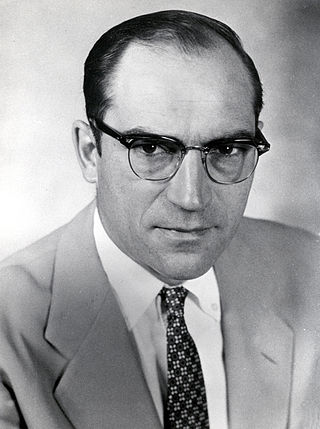Related Research Articles

William Grant Still Jr. was an American composer of nearly two hundred works, including five symphonies, four ballets, nine operas, over thirty choral works, plus art songs, chamber music and works for solo instruments. Born in Mississippi, he grew up in Little Rock, Arkansas, attended Wilberforce University and Oberlin Conservatory of Music, and was a student of George Whitefield Chadwick and later, Edgard Varèse. Because of his close association and collaboration with prominent African-American literary and cultural figures, Still is considered to have been part of the Harlem Renaissance.
Erich Stephen Gruen is an American classicist and ancient historian. He was the Gladys Rehard Wood Professor of History and Classics at the University of California, Berkeley, where he taught full-time from 1966 until 2008. He served as president of the American Philological Association in 1992.
Henry Farnum May was an American historian and Margaret Byrne Professor of History, University of California, Berkeley.

Wayne Morris was an American film and television actor, as well as a decorated World War II fighter ace. He appeared in many films, including Paths of Glory (1957), The Bushwackers (1952), and the title role of Kid Galahad (1937).

Luna Bergere Leopold was a leading U.S. geomorphologist and hydrologist, and son of Aldo Leopold. He received a B.S. in civil engineering from the University of Wisconsin in 1936; an M.S. in physics-meteorology from the University of California, Los Angeles in 1944; and a Ph.D. in geology from Harvard University in 1950.
Gregory Samuel Ain was an American architect active in the mid-20th century. Working primarily in the Los Angeles area, Ain is best known for bringing elements of modern architecture to lower- and medium-cost housing. He addressed "the common architectural problems of common people".

Kevin Owen Starr was an American historian and California's state librarian, best known for his multi-volume series on the history of California, collectively called "Americans and the California Dream."

Donald Woods was a Canadian-American film and television actor whose career in Hollywood spanned six decades.
John Carl Parish was an American historian of American history.
Sandra Annear Thompson is an American linguist specializing in discourse analysis, typology, and interactional linguistics. She is Professor Emerita of Linguistics at the University of California, Santa Barbara (UCSB). She has published numerous books, her research has appeared in many linguistics journals, and she serves on the editorial board of several prominent linguistics journals.

David Hawkins was a professor whose interests included the philosophy of science, mathematics, economics, childhood science education, and ethics. He was also an administrative assistant at the Manhattan Project's Los Alamos Laboratory and later one of its official historians. Together with Herbert A. Simon, he discovered and proved the Hawkins–Simon theorem.

Harry Leon Wilson was an American novelist and dramatist best known for his novels Ruggles of Red Gap and Merton of the Movies. Another of his works, Bunker Bean, helped popularize the term "flapper".
Arthur Gilchrist Brodeur was a scholar of early English, German, and Old Norse literature at the University of California, Berkeley. He is known primarily for his scholarly work on Beowulf and his translation of Snorri Sturluson's Prose Edda for The American-Scandinavian Foundation, but also as a writer of pulp fiction and for his left-wing politics.
Truesdell Sparhawk Brown was a classical scholar, ancient historian, and co-founder of the journal California Studies in Classical Antiquity, which became the journal Classical Antiquity.
Archer Taylor was one of America's "foremost specialists in American and European folklore", with a special interest in cultural history, literature, proverbs, riddles and bibliography.

Richard Marshall Eakin, was an American zoologist and professor at the University of California, Berkeley. He was widely known for portraying prominent historical scientists during some of his lectures; dressing in costume and speaking in character to entertain and inform his students. A 1953 Guggenheim fellow, he wrote several books and more than 200 scientific papers. His research focused on eyes and vision in animals, especially the parietal eye or "third eye" of vertebrates, as well as animal embryology. He served as chairman of the UC Berkeley Department of Zoology for over 10 years, was elected president of the Western Society of Naturalists and American Society of Zoologists, and was a fellow of the California Academy of Sciences.

Kris D. Gutiérrez is an American professor of learning sciences and literacy. She currently holds the Carol Liu Chair in Educational Policy at the University of California, Berkeley and formerly held the Inaugural Provost's Chair at University of Colorado, Boulder. She is professor emerita of the University of California, Los Angeles. She has specialized in "culture and learning in urban schools," according to the Los Angeles Times. She is a member of the National Academy of Education. In April 2020, Gutiérrez was elected as a member of the American Academy of Arts and Sciences.
Frank Kreith was an American mechanical engineer.
Richard Alan McCray was an American astronomer and astrophysicist.

James Gilluly was an American geologist.
References
- 1 2 3 4 5 6 "Dixon Wecter, History; English: Berkeley and Los Angeles". Calisphere . Retrieved October 14, 2018.
- 1 2 3 4 "DIXON WECTER". John Simon Guggenheim Memorial Foundation. Retrieved October 14, 2018.
- ↑ Levens, R.G.C., ed. (1964). Merton College Register 1900–1964. Oxford: Basil Blackwell. p. 204.
- 1 2 "Death Takes Dixon Wecter, ex-Professor" . The Los Angeles Times. June 26, 1950. p. 5. Retrieved October 14, 2018– via Newspapers.com.
- ↑ "Dr. Wecter Dies Suddenly After His 'Greatest Address'" . The Waco News-Tribune. Waco, Texas. June 26, 1950. p. 1. Retrieved October 14, 2018– via Newspapers.com.
- ↑ "Death Takes Dixon Wecter, Ex-Professor". Los Angeles Times. 26 June 1950. p. 5.